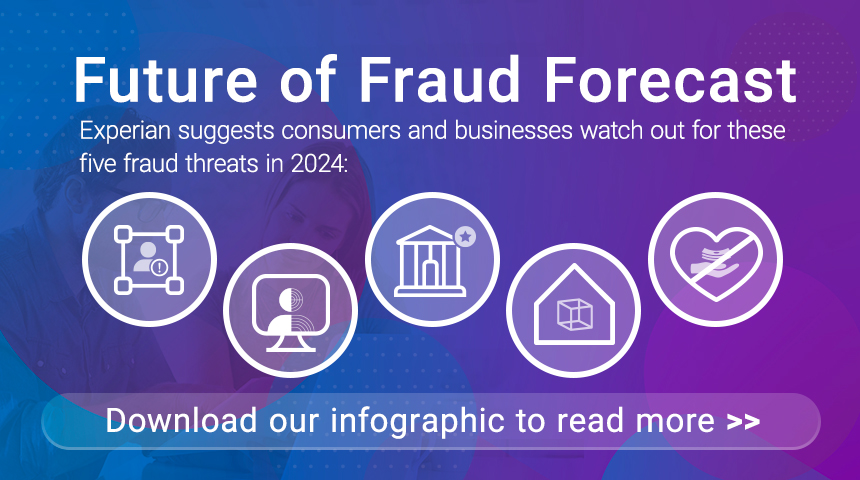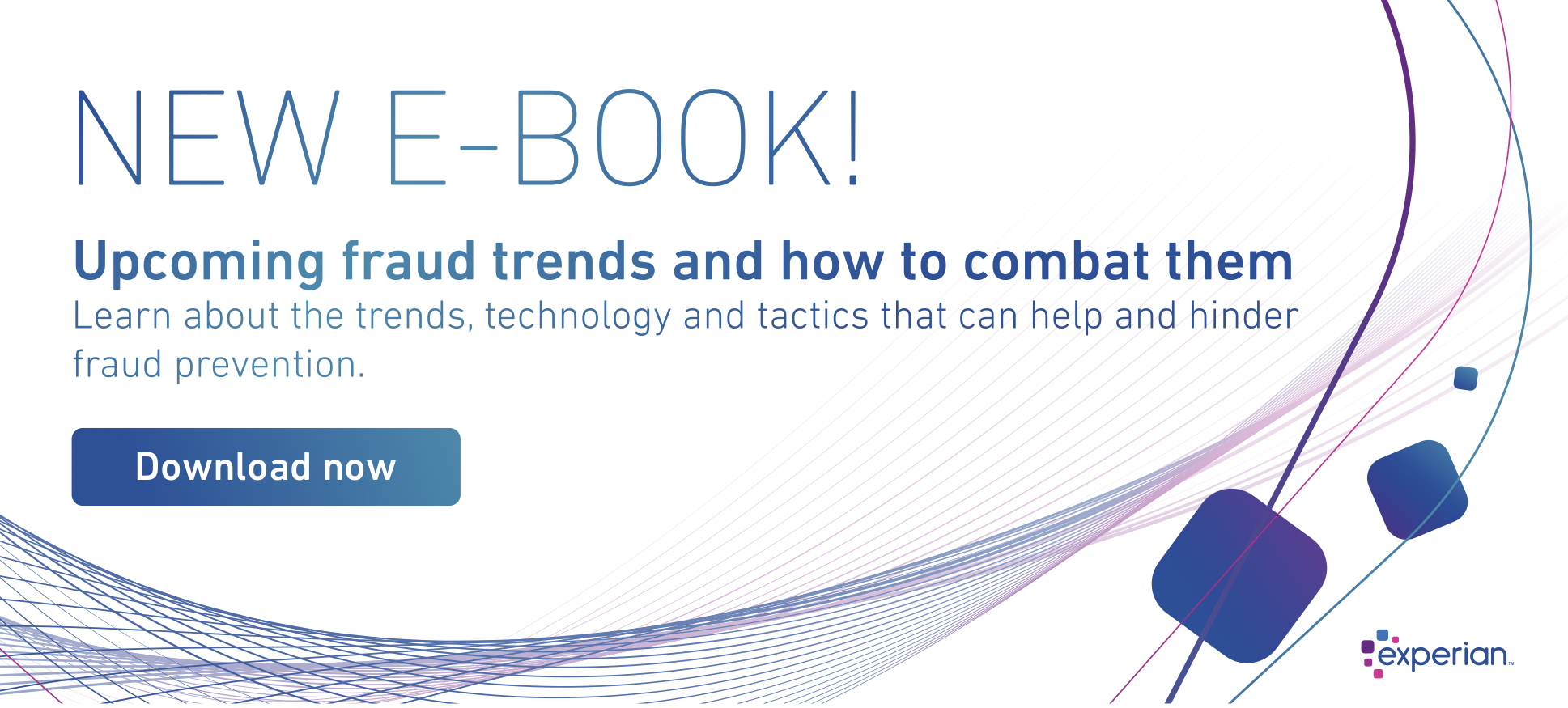Tag: account opening

Spoiler alert: Gen AI is everywhere, including the top of Experian’s list of fraud trends 2024. “The speed and complexity of fraud attacks due to new technology and sophisticated fraudsters is leaving both businesses and consumers at risk in 2024,” said Kathleen Peters, chief innovation officer at Experian Decision Analytics in North America. “At Experian, we’re constantly innovating to deliver data-driven solutions to help our customers fight fraud and to protect the consumers they serve.” To deter fraudulent activity in 2024, businesses and consumers must get tactical for their fraud fighting strategies. And for businesses, the need for more sophisticated fraud protection solutions leveraging data and technology is greater than ever before. Experian suggests consumers and businesses watch out for these big five rounding out our fraud trends 2024. Generative AI: Generative AI accelerates DIY fraud: Experian predicts fraudsters will use generative AI to accelerate “do-it-yourself” fraud ranging from deepfake content – think emails, voice and video – as well as code creation to set up scam websites. A previous blog post of ours highlighted four types of generative AI used for fraud, including fraud automation at scale, text content generation, image and video manipulation and human voice generation. The way around it? Fight AI fraud with AI as part of a multilayered fraud prevention solution. Fraud at bank branches: Bank branches are making a comeback. A growing number of consumers prefer visiting bank branches in person to open new accounts or get financial advice with the intent to conduct safer transactions. However, face-to-face verification is not flawless and is still susceptible to human error or oversight. According to an Experian report, 85% of consumers report physical biometrics as the most trusted and secure authentication method they’ve recently encountered, but the measure is only currently used by 32% of businesses to detect and protect against fraud. Retailers, beware: Not all returns are as they appear. Experian predicts an uptick in cases where customers claim to return their purchases, only for the business to receive an empty box in return. Businesses must be vigilant with their fraud strategy in order to mitigate risk of lost goods and revenue. Synthetic identity fraud will surge: Pandemic-born synthetic identities may have been dormant, but now have a few years of history, making it easier to elude detection leading to fraudsters using those dormant accounts to “bust out” over the next year. Cause-related and investment deception: Fraudsters are employing new methods that strike an emotional response from consumers with cause-related asks to gain access to consumers’ personal information. Experian predicts that these deceptive cause-related methods will surge in 2024 and beyond. How businesses and consumers feel about fraud in 2024 According to an Experian report, over half of consumers feel they’re more of a fraud target than a year ago and nearly 70% of businesses report that fraud losses have increased in recent years. Business are facing mounting challenges – from first-party fraud and credit washing to synthetic identity and the yet-to-be-known impacts generative AI may have on fraud schemes. Synthetic identity fraud has been mentioned in multiple Experian Fraud Forecasts and the threat is ever growing. As technology continues to enhance consumers’ connectedness, it also heightens the stakes for various fraud attacks. As highlighted by this list of fraud trends 2024, the ways that fraudsters are looking to deceive is increasing from all angles. “Now more than ever, businesses need to implement a multilayered approach to their identity verification and fraud prevention strategies that leverages the latest technology available,” said Peters. Consumers are increasingly at risk from sophisticated fraud schemes. Increases in direct deposit account and check fraud, as well as advanced technologies like deepfakes and AI-generated phishing emails, put consumers in a precarious position. The call to action for consumers is to remain vigilant of seemingly authentic interactions. Experian can help with your fraud strategy To learn more about Experian’s fraud prevention solutions, please visit https://www.experian.com/business/solutions/fraud-management. Download infographic Watch Future of Fraud webinar

This article was updated on November 9, 2023. Fraud – it’s a word that comes up in conversations across every industry. While there’s a general awareness that fraud is on the rise and is constantly evolving, for many the full impact of fraud is misunderstood and underestimated. At the heart of this challenge is the tendency to lump different types of fraud together into one big problem, and then look for a single solution that addresses it. It’s as if we’re trying to figure out how to un-bake a terrible cake instead of thinking about the ingredients and the process needed to put them together in the first place. This is the first of a series of articles in which we’ll look at some of the key ingredients that create different types of fraud, including first party, third party, synthetic identity, and account takeover. We’ll talk about why they’re unique and why we need to approach each one differently. At the end of the series, we’ll get a result that’s easier to digest. I had second thoughts about the cake metaphor, but in truth it really works. Creating a good fraud risk management process is a lot like baking. We need to know the ingredients and some tried-and-true methods to get the best result. With that foundation in place, we can look for ways to improve the outcome every time. Let’s start with a look at the best known type of fraud, third party. What is third-party fraud? Third-party fraud – generally known as identity theft – occurs when a malicious actor uses another person’s identifying information to open new accounts without the knowledge of the individual whose information is being used. When you consider first-party vs third-party fraud, or synthetic identity fraud, third-party stands out because it involves an identifiable victim that’s willing to collaborate in the investigation and resolution, for the simple reason that they don’t want to be responsible for the obligation made under their name. Third-party fraud is often the only type of activity that’s classified as fraud by financial institutions. The presence of an identifiable victim creates a high level of certainty that fraud has indeed occurred. That certainty enables financial institutions to properly categorize the losses. Since there is a victim associated with it, third party fraud tends to have a shorter lifespan than other types. When victims become aware of what’s happening, they generally take steps to protect themselves and intervene where they know their identity has been potentially misused. As a result, the timeline for third-party fraud is shorter, with fraudsters acting quickly to maximize the funds they’re able to amass before busting out. How does third-party fraud impact me? As the digital transformation continues, more and more personally identifiable information (PII) is available on the dark web due to data breaches and phishing scams. Given that consumer spending is expected to increase1, we anticipate that the amount of PII readily available to criminals will only continue to grow. All of this will lead to identity theft and increase the risk of third-party fraud. More than $43 billion in total losses was reported due to identity theft and fraud in the U.S. in 2022.2 Solving the third-party fraud problem We’ve examined one part of the fraud problem, and it is a complex one. With Experian as your partner, solving for it isn’t. Continuing my cake metaphor, by following the right steps and including the right ingredients, businesses can detect and prevent fraud. Third-party fraud detection and prevention involves two distinct steps. Analytics: Driven by extensive data that captures the ways in which people present their identity—plus artificial intelligence and machine learning—good analytics can detect inconsistencies, and patterns of usage that are out of character for the person, or similar to past instances of known fraud. Verification: The advantage of dealing with third-party fraud is the availability of a victim that will confirm when fraud is happening. The verification step refers to the process of making contact with the identity owner to obtain that confirmation and may involve identity resolution. It does require some thought and discipline to make sure that the contact information used leads to the identity owner—and not to the fraudster. In a series of articles, we’ll be exploring first-party fraud, synthetic identity fraud, and account takeover fraud and how a layered fraud management solution can help keep your business and customers safe and manage third-party fraud detection, first-party fraud, synthetic identity fraud, and account takeover fraud prevention. Let us know if you’d like to learn more about how Experian is using our identity expertise, data, and analytics to create robust fraud prevention solutions. Contact us 1 Experian Ascend Sandbox 2 2023 U.S. Identity and Fraud Report, Experian.

As stimulus-generated fraud wanes, we anticipate a return of more traditional forms of fraud, including account opening fraud. As businesses embrace the digital evolution and look ahead to responsible growth, it’s important to balance the customer experience with the risks associated with account opening fraud. Preventing account opening fraud requires a layered fraud and identity management strategy that allows you to approve good customers while keeping criminals out. With the right tools in place, you can optimize the customer experience while still keeping risk low. Download infographic Review your fraud strategy

The sharp uptick in fraud that coincided with the digital evolution made it clear that banks, credit unions, and fintechs need to invest in a strategy that utilizes identity layers to keep their customers and their finances safe. The steady rise in fraud over the last several years spiked—payment fraud rose 70% last year and is expected to increase by 95% in 2021—making it more challenging than ever to address the fraud threat while meeting increasing customer expectations. The rising fraud threat 2020 saw a rapid influx of customers using digital channels and the amount of data flowing into financial systems. There’s been a seismic shift, and we’re not going back. According to a recent study, 80% of consumers now prefer to manage their finances digitally, leaving the door open for fraudsters to take advantage of digital newbies. The increase in online activity corresponded with criminal activity. The rates of synthetic identity, account opening, and account takeover fraud have risen as fraudsters’ tactics have evolved. 80% of fraud losses now come from synthetic identities In 2020 the rate of new account credit card fraud attempts rose 48% Account takeover accounted for 54% of all fraud attacks in 2020 Fraudsters will continue to take advantage of current conditions, moving from stimulus-related fraud back to more traditional forms of financial theft, and financial institutions must adapt in turn with robust identity layers. Resolving the identity threat In our recent white paper, developed in partnership with One World Identity, we explore how businesses can address the fraud threat. It requires a multilayered identity proofing strategy for both onboarding and ongoing authentication. By doing this, financial institutions can gain a holistic view of consumers and their associated risks, decreasing friction while enabling robust fraud protection. To learn more, download our “Improving Fraud by Increasing Identity Layers” white paper. Download white paper

In 2015, U.S. card issuers raced to start issuing EMV (Europay, Mastercard, and Visa) payment cards to take advantage of the new fraud prevention technology. Counterfeit credit card fraud rose by nearly 40% from 2014 to 2016, (Aite Group, 2017) fueled by bad actors trying to maximize their return on compromised payment card data. Today, we anticipate a similar tsunami of fraud ahead of the Social Security Administration (SSA) rollout of electronic Consent Based Social Security Number Verification (eCBSV). Synthetic identities, defined as fictitious identities existing only on paper, have been a continual challenge for financial institutions. These identities slip past traditional account opening identity checks and can sit silently in portfolios performing exceptionally well, maximizing credit exposure over time. As synthetic identities mature, they may be used to farm new synthetics through authorized user additions, increasing the overall exposure and potential for financial gain. This cycle continues until the bad actor decides to cash out, often aggressively using entire credit lines and overdrawing deposit accounts, before disappearing without a trace. The ongoing challenges faced by financial institutions have been recognized and the SSA has created an electronic Consent Based Social Security Number Verification process to protect vulnerable populations. This process allows financial institutions to verify that the Social Security number (SSN) being used by an applicant or customer matches the name. This emerging capability to verify SSN issuance will drastically improve the ability to detect synthetic identities. In response, it is expected that bad actors who have spent months, if not years, creating and maturing synthetic identities will look to monetize these efforts in the upcoming months, before eCBSV is more widely adopted. Compounding the anticipated synthetic identity fraud spike resulting from eCBSV, financial institutions’ consumer-friendly responses to COVID-19 may prove to be a lucrative incentive for bad actors to cash out on their existing synthetic identities. A combination of expanded allowances for exceeding credit limits, more generous overdraft policies, loosened payment strategies, and relaxed collection efforts provide the opportunity for more financial gain. Deteriorating performance may be disguised by the anticipation of increased credit risk, allowing these accounts to remain undetected on their path to bust out. While responding to consumers’ requests for assistance and implementing new, consumer-friendly policies and practices to aid in impacts from COVID-19, financial institutions should not overlook opportunities to layer in fraud risk detection and mitigation efforts. Practicing synthetic identity detection and risk mitigation begins in account opening. But it doesn’t stop there. A strong synthetic identity protection plan continues throughout the account life cycle. Portfolio management efforts that include synthetic identity risk evaluation at key control points are critical for detecting accounts that are on the verge of going bad. Financial institutions can protect themselves by incorporating a balance of detection efforts with appropriate risk actions and authentication measures. Understanding their portfolio is a critical first step, allowing them to find patterns of identity evolution, usage, and connections to other consumers that can indicate potential risk of fraud. Once risk tiers are established within the portfolio, existing controls can help catch bad accounts and minimize the resulting losses. For example, including scores designed to determine the risk of synthetic identity, and bust out scores, can identify seemingly good customers who are beginning to display risky tendencies or attempting to farm new synthetic identities. While we continue to see financial institutions focus on customer experience, especially in times of uncertainty, it is paramount that these efforts are not undermined by bad actors looking to exploit assistance programs. Layering in contextual risk assessments throughout the lifecycle of financial accounts will allow organizations to continue to provide excellent service to good customers while reducing the increasing risk of synthetic identity fraud loss. Prevent SID

One of the most difficult parts of combating fraud is the ability to distinguish between the variety of fraud types. To properly manage your fraud efforts, you need to be able to differentiate between first party fraud and third party fraud so you can determine the best treatment. After all, if you’re treating first party fraud as though it’s third party fraud, the customer you’re contacting for verification will give whatever information they need to in order to continue their criminal actions. So how do you verify each type of fraud without adding additional overhead or increasing the friction experienced by your customers? Combating Fraud During an Economic Downturn Particularly in times of economic uncertainty, the ability to detect and identify individual fraud types allows you to work to prevent them in the future. Through proper identification, you can also apply the correct treatments to maximize the effectiveness of your fraud response teams, since the treatment for first and third party fraud is different. During the economic upswing, first party fraud was a secondary concern. Businesses were easing friction to help continue growth. Now, the same customers that businesses thought would drive growth are hurting and unable to help offset the losses caused by bad actors. Now is the time to revisit existing fraud prevention and mitigation strategies to ensure that fraud is properly identified, and the correct treatments are applied. Introducing Precise ID® Model Suite Experian’s Precise ID Model Suite combines identity analytics with advanced fraud risk models to: Protect the entire customer journey again fraud – across account opening, login, maintenance and transactions Distinguish first-party, third-party, and synthetic identity fraud to determine the best next action Enable agility during changing market conditions Maintain regulatory compliance (including: KYC, CIP, GLBA, FCRA, FFIEC, PATRIOT Act, FACTA, and more) Improve overall fraud management strategies and reduce losses Precise ID Model Suite allows you to detect and distinguish types of fraud with a single call – enabling your business to maximize efficiency and eliminate redundancy across your fraud prevention teams. By accurately recognizing risk, and in particular, recognizing that first party fraud is in fact a type of fraud distinct from credit risk, you’re able to protect your portfolio and your customers. Learn more

Digital channels undoubtedly create convenient experiences for consumers. We have the luxury of applying for loans or creating investment accounts from the comfort of home. However, the same opportunities are available to fraudsters. Fraudsters continue to find creative and innovative ways to expose vulnerabilities across all types of businesses. They prey on inexperienced or low-bandwidth teams that have not invested in the appropriate fraud tools in the past. Despite the imminent fraud risk involved, both consumers and businesses continue to embrace digital channels. With 90 percent of consumers worldwide conducting personal banking online, how do we protect these digital platforms with finite resources? A leading digital financial services company was forced to address this question when they experienced a large-scale fraud attack. But they weren’t in this fight alone. Download the full case study to see how our risk analyst used FraudNet to prevent millions of dollars in fraudulent funding. Client: A leading digital financial services company that operates with zero in-person branches with more than 7,000 employees Challenge/Objective: In October 2018, fraudsters deployed a large-scale, scripted attack against a North American financial services company. The fraud team was extremely understaffed. The fraud team was unable to detect and respond to the attack quickly. The fraudulent account opening activities eventually blended into account takeovers. Resolution: Our risk analyst worked quickly to analyze the geolocation, velocity and device rules firing within FraudNet for Account Opening. By having these rules in place, FraudNet was able to flag and outsort thousands of suspicious applications. Despite being a small team, the fraud investigators were able to work efficiently within the FraudNet workbench and review the true, high-risk applications. Results: Thanks to our risk analyst’s quick remediation and the FraudNet proprietary device rules: 23,800 fraudulent applications were outsorted for review. An estimated $35.7 million in fraudulent funding was prevented. However, the fight against fraud is ongoing. Our risk analyst continues to work closely with the fraud team to develop an effective strategy to prepare against future attacks.

You can do everything you can to prepare for the unexpected. But similar to how any first-time parent feels… you might need some help. Call in the grandparents! Experian has extensive expertise and has been around for a long time in the industry, but unlike your traditional grandparents, Experian continuously innovates, researches trends, and validates best practices in fraud and identity verification. That’s why we explored two prominent fraud reports, Javelin’s 2019 Identity Fraud Study: Fraudsters Seek New Targets and Victims Bear the Brunt and Experian’s 2019 Global Identity and Fraud Report — Consumer trust: Building meaningful relationships online, to help you identify and respond to new trends surrounding fraud. What we found – and what you need to know – is there are trends, technology and tactics that can help and hinder your fraud-prevention efforts. Consider the many digital channels available today. A full 91 percent of consumers transacted online in 2018. This presents a great opportunity for businesses to serve and develop relationships with customers. It also presents a great opportunity for fraudsters as well – as almost half of consumers have experienced a fraudulent online event. Since the threat of fraud is not impacting customers’ willingness to transact online, businesses are held responsible for adapting and evolving to not only protect their customers, but to secure their bottom line. This becomes increasingly important as fraudsters continue to target and expose vulnerabilities across inexperienced lines of businesses. Or, how about passwords. Research has shown that both businesses and consumers have greater confidence in biometrics, but neither is ready to stop using passwords. The continued reliance on traditional authentication methods is a delicate balance between security, trust and convenience. Passwords provide both authentication and consumer confidence in the online experience. It also adds friction to the user experience – and sometimes aggravation when passwords are forgotten. Advanced methods, like physical and behavioral biometrics and device intelligence, are gaining user confidence by both businesses and consumers. But a completely frictionless authentication experience can leave consumers doubting the safeness of their transaction. As you respond and adapt to our ever-evolving world, we encourage you to build and strengthen a trusted relationship with your customers through transparency. Consumers know that businesses are collection data about them. When a business is transparent about the use of that data, digital trust and consumer confidence soars. Through a stronger relationship, customers are more willing to accept friction and need fewer signs of security. Learn more about these and other trends, technology and tactics that can help and hinder your authentication efforts in our new E-book, Upcoming fraud trends and how to combat them.

Attract and retain high-value demand deposit accounts The excitement of the new year has ended, and now the big question remains: What will 2016 hold for our market and the economy? So far, we’ve seen this election year bring a volatile financial market: The Federal Reserve increased short-term interest rates by 25 basis in December, and there is uncertainty if and when future increases will come China’s gross domestic product is forecasted at 6.5 percent, the lowest in a quarter century The Dow Jones industrial average is down 10 percent to start the year, signaling a lot of uncertainty for banks and consumers It’s hard to find answers in a shifting financial landscape with a long list of mixed signals. The average consumer is looking on and wondering if we face another Great Recession or if the current economy is spiking a fever just before it is completely cured. The reality, for those of us in the banking industry, is that the modest economic recovery is likely to continue as part of a new normal pattern. In 2016, banks that remain competitive in a more digital world will be those that have frictionless products and processes to attract and retain high-value, highly sought-after consumer deposits and loans. Banks should expect the competition for deposits to intensify, and they will need to ensure that new deposit customers are on boarded effectively and cross-sold loan products quickly to reduce first-year attrition. Cross-selling at the point of origination for the demand deposit account (DDA) customers is the best way to ensure that new customers keep the institution as their primary bank. Financial institutions can exceed consumer expectations and ensure a competitive business model by leveraging modernized technology capabilities fully in combination with making relevant decisions to deliver consumer-friendly experiences. First-year DDA attrition rates will demonstrate how the consumer’s expectations were met and if the new bank got the account-opening process right or wrong. Experian® suggests three capabilities clients should consider: A deposits technology platform that offers frictionless change to data, origination strategies and instant cross-sell to loan products that yield sticky customers Strategies that comply with current and evolving regulatory demands, such as those being sought by the Consumer Financial Protection Bureau (CFPB) Business planning to identify execution gaps and a road map to ensure that gaps are addressed, confirming continued competitive ability to attract high-value deposit and loan customers DDA-account opening effectiveness can be achieved by using a consumer’s life stage, affordability considerations, unique risk profile and financial needs to on board optimally and grow those high-value consumers effectively and efficiently. Financial institutions that are nimble and fast adopters of these critical capabilities will reduce operating expenses for their organizations, grow sustainable revenue from new prospects and customers, and delight those new customers along the way. This is a win-win for banks and consumers. Join me next week as we discuss best practices across the entire demand deposit account life cycle.